Caring for your lawn is a great feeling. You've worked toward this moment, and now the grass under your feet is in your hands. By learning how to care for your lawn, you can see your plans for lush, thick turf and backyard entertaining come true. Below is a paraphrase from Conrad's Fall Lawn Renovation seminar held at Decker's Nursery. Take on your lawn one task at a time, and work through these lawn care basics
There's no such thing as a perfect lawn. The more "perfect" you want your lawn to appear; the more you have to rely on pesticides and herbicides to maintain this condition.
You will be more successful if you recognize lawn maintenance as a process that continues every year. The lawn will improve equivalent with your efforts and commitment; likewise, it will decline equivalent with your lack of efforts.
As your lawn becomes more thick and lush, it will naturally suppress many of the weeds that compromise it. This is your objective so less herbicides will be required.
Turf grass does not belong on Long Island, it's not native or "normal". This is why it requires so much effort. Society has established an expectation for lawns in our landscapes and it's a maintenance "drain", requiring $1000's to keep them in a suitable condition (mowed, watered, and basic care).
One way to reduce your lawn maintenance costs is to increase your knowledge of what lawns need to be healthy and to understand the products necessary for maintenance of the lawn. When you time your applications and treatments properly, it improves the results and reduces costs.
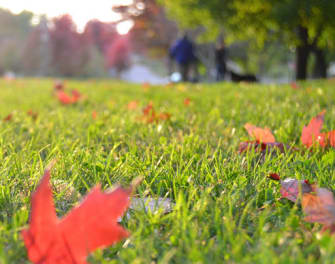
Give up on spring seeding and make a point of planting grass seed every fall.
Planting Grass seed each fall will improve your lawn. Over the course of several years, a healthier, more full lawn will compete with crabgrass and other weeds. As the condition of your lawn improves you can practically eliminate the need for weed control. Keep the turf in good condition by mowing at 3.5" and watering properly.
Lawns require nutrients to be healthy. Fertilizer is how you supplement the nutrient needs of your turf grass. Provide 4 or 5 well timed applications of fertilizer when the grass will benefit the most. The goal is to get the lawn in a condition where 4 fertilizer treatments will suffice.
- Spring - 2 applications 30 days apart starting in early April
- Fall - 2 or 3 applications starting when temperatures are not above 80, consistently. Fall applications can be 21-30 days apart. If you're just starting the renovation process consider doing 3 treatments 21 days apart, starting around Labor Day. Late Fall fertilization benefits the turf in the following spring season, with an early green-up.
Many nutrients already exist in our native soils; however they are chemically bound to soil particles because of the pH. Lawns are most healthy when soil pH is between 6.5 & 7. They perform their biological functions more efficiently when pH is favorable. Soil pH can be manipulated towards alkaline conditions by applying lime. Most native soils on Long Island are naturally acidic and require lime applications to create a conducive condition. Soil tests are beneficial and direct us more accurately on how to adjust the pH.
After 30 years of reviewing analysis', I can confidently say your lawn will benefit from an application. Applying large amounts of anything, including lime is not a good thing. Spread your Lime applications out over the course of the year including late summer before the fall fertilizer Is applied. It's better to do multiple applications over a longer window, than to do a heavy treatment once or twice.
If you follow all these maintenance treatments you will see a significant improvement with how your lawn appears this year and in the spring. Even if you use conventional fertilizer, you've made a minimal footprint, environmentally. Make sure you perform all these treatments properly. Proper dosage of fertilizer, thorough application of lime, seeding the lawn and watering properly. Increase the height of the mowing and continue to water properly when nature isn't helping.
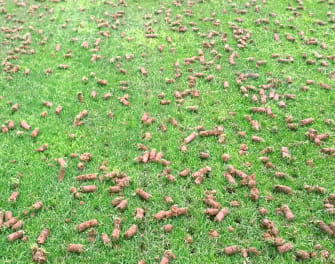
How to Aerate & Seed your Lawn - Aeration is another cultural method of maintenance that's best performed in fall. It improves the efficacy of your seeding efforts and also reduces thatch.
You can either rent an aerator or contract someone to aerate your lawn. Always perform a double pass in opposite directions and it would be difficult to "over" aerate. The more you aerate the better the seeding results.
- Always mark your irrigation heads to prevent damage from the equipment.
- Do not aerate in spring, the holes can increase desiccation of the soil and turf grass roots. It Also negates any preventative application of crabgrass control.
- Address any problematic areas of the lawn by tilling, or cultivating compacted conditions. Use a "Garden Weasel" to prepare the soil and incorporate organic matter into the soil. Be Sure to till deep enough to change the conditions and prevent recurring damage to the soil.
Use a spreader to apply your grass seed. Decker's Nursery offers a very good quality grass seed that's manufactured by the same company that provides grass seed for professional ball fields.
- Select the appropriate type of seed - Sun (6 hours or more sunlight), Sun & Shade (less than 6 hours of sunlight), Shade (minimal amounts of sunlight). Grass will not perform well in heavy shade. Consider modifying your landscape into gardens if you have full shade conditions.
- Apply 1 pound of grass seed for every 1000/sf of lawn you're treating (2 lbs. of seed per 1000/sf if there's no existing grass) You can increase the amount and it may improve the results. There is a point where too much seed is wasteful. Do not use more than 3 lbs. of seed per 1000/sf of lawn.
- Get an even distribution of grass seed over as large an area as practical. Use the hand spreader in small areas.
Upon completion of the aerating and seeding it's critical to irrigate the lawn. This will force the seed to make contact with the soil. It's prudent to apply a starter fertilizer to assist with the germination process. Grass seed will not germinate if it dries out. Water the new seed for 10-15 minutes - two or three times a day until all the seed germinates.
It's also a good idea to do a thorough watering of your lawn prior to applying grass seed. Double the time you usually irrigate to assure saturation.
Fall seeding usually takes 5 to 7 days till the seed germinates. Get down into the soil to inspect the seedlings that emerge. Look for seeds that didn't germinate yet and determine how much longer you need to keep watering. Upon complete germination, return to normal watering as advised
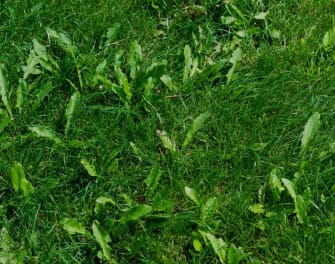
At this point, many homeowners become concerned with existing weeds. If your lawn is like mine, the weeds have taken over the lawn completely. This is when you have to make a decision of how committed you are to an organic method of Lawn Maintenance. Weeds will compete with the new grass and may diminish the seeding results, depending on how tenacious the weeds are.
Do not be concerned with existing crabgrass, it's going to die in October and new seed will emerge in its place.
Do not think that you have to kill weeds to improve your lawn. It may take longer to get where you want to be, and you will still see a visual improvement. If you want to treat the weeds to improve your results, and remain committed to minimal treatments for weeds there is a good compromise. Always spot treat weeds versus a blanket application. You will reduce your pesticide exposure by at least 75%.
A pump sprayer with a recommended "selective herbicide" works best when temperatures are 75 degrees or less. Lawn weeds are cool weather plants, like turf grass. They metabolize the treatment more efficiently when temperatures are cooler. If you decide to treat weeds, include an adjuvant to improve the efficacy of the treatment, it's worth the cost and reduces the amount of product you need to apply.
There isn't a great "homeowner" product for Nutsedge. Treatment of Nutsedge requires a separate treatment with a different product, thereby increasing your exposure to pesticides. Nutsedge will disappear as quickly as it arrived and doesn't have a long term effect on your lawn. Its a temporary nuisance.

Continue maintaining your lawn with sound cultural methods as recommended below:
Remember to follow County ordinance and do not apply fertilizer after Oct. 31. It has been my experience that late fall applications can be very beneficial as long as the weather conditions are favorable. It makes a big difference with how your lawn appears in late March / April.
Allow your new seedlings to mature before you start mowing. Usually 10-14 days after the seed has been installed, you can return to mowing your lawn, normally. Mowing has a large bearing on the health and vigor of your lawn. Unless you're mowing at 3"-3.5" already, you need to adjust your mower to allow the grass to grow longer.
Keep your blades sharp. There are hand held sharpeners for between mowings. Have the blades sharpened professionally each winter and summer when the "dog days" require less mowing. Avoid scalping your lawn with uneven terrain. Change your mowing pattern and follow any other recommendations on mowing that you read.
Everyone with an irrigation system seems to do more damage than helping the lawn. By the way, weeds love constant short watering. It makes them healthier than the turf.
Replicate nature. Your lawn always looks best following a heavy rain storm (tropical storm),
The reason is because the soil was saturated thoroughly. During the growing season, your lawn can be irrigated twice a week and be more healthy. This is especially true during the summer months when turf grass diseases are most prevalent.
Repetitive short watering periods do not help turf grass, just the weeds. Do not start irrigating your lawn until it's needed. If it's raining consistently in May, wait a while before starting your system. Irrigation can do more harm than good, it's a substitute for times when nature isn't helping us.
Water less often and saturate your lawn when you do water. Use a rain gauge to determine how long it takes to provide an inch of rainfall. Set your timer for this length of time. Two or Three times a week.
Continue to fertilize your lawn through the fall. You can make your final application as close to October 31 as weather conditions dictate. It's a good idea to apply fertilizer to moist soil to prevent burning. Never apply fertilizer to drought stressed lawns.
- Know your square footage to make sure you're applying fertilizer at the recommended rates.
- Keep your spreader in good condition. Grease the bearings on the tires when appropriate.
Avoid over spray of product into the street or on hardscapes. This is how fertilizer ends up in our water systems. Fertilizer will not harm your flower and shrub gardens.
Ideally, as your lawn improves it's health and vigor the turf grass will suppress most of the damaging weeds, including crabgrass. Do not strive to eradicate weeds in your lawn, it will NOT happen. Thin areas of the lawn will remain your problematic areas and as the weeds diminish, you can pull them out if they're a concern.
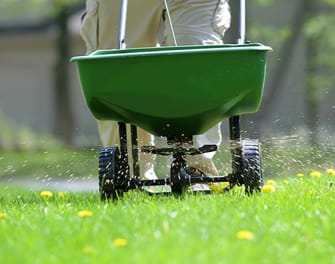
Use chemical treatments for weeds as little as possible. If you opt to use them, always do spot treatments to minimize your usage. If your lawn has declined to a stage where weed control is necessary, do not make treatments preventative. Only treat the weeds you see and be willing to accept some weeds.
- Using herbicides is a personal decision and your goal should be to eliminate them as the condition of your lawn improves.
- Do not apply weed control in high temperatures because they do not work.
- Use an adjuvant in your herbicide applications to improve the efficacy and minimize the usage.
Lawns are a significant component of our landscapes. I believe it's better to maintain them responsibly than not at all and if you only learn one thing from today's presentation, Lawn Maintenance is a continuous process. You will get out of it what you put into it. Sound Cultural practices are the best way to improve the condition of your lawn.
- Mow at 3-3.5"
- Water thoroughly, equivalent to an inch of rainfall - twice a week - 3 days if necessary. Do not be afraid to increase the time. If that's what's required, it will provide results.
- Over seed your lawn each fall, as close to Labor Day as the weather allows.
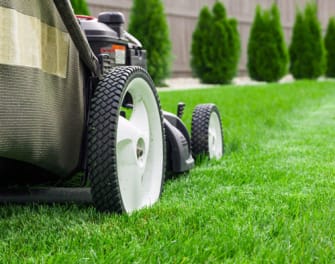
Change your perception of what constitutes a healthy lawn, tolerate some weeds and tolerate that the lawn will not look great in summer months. Adding water, fertilizer, or lime is not going to change the way the lawn appears during the dog days of summer. It's a cool weather plant that looks best in spring and fall. Any treatments during the summer are usually a waste of effort, money and unnecessary pesticides.
